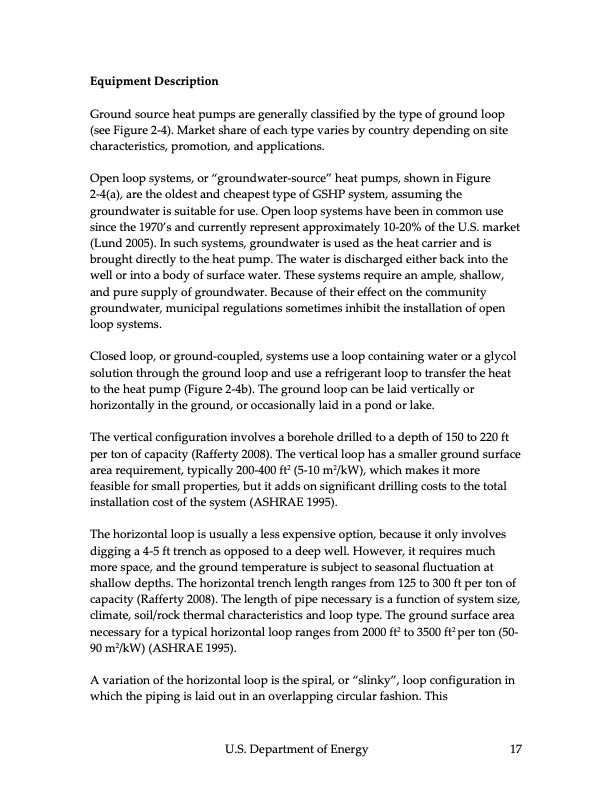
PDF Publication Title:
Text from PDF Page: 018
Equipment Description Ground source heat pumps are generally classified by the type of ground loop (see Figure 2‐4). Market share of each type varies by country depending on site characteristics, promotion, and applications. Open loop systems, or “groundwater‐source” heat pumps, shown in Figure 2‐4(a), are the oldest and cheapest type of GSHP system, assuming the groundwater is suitable for use. Open loop systems have been in common use since the 1970’s and currently represent approximately 10‐20% of the U.S. market (Lund 2005). In such systems, groundwater is used as the heat carrier and is brought directly to the heat pump. The water is discharged either back into the well or into a body of surface water. These systems require an ample, shallow, and pure supply of groundwater. Because of their effect on the community groundwater, municipal regulations sometimes inhibit the installation of open loop systems. Closed loop, or ground‐coupled, systems use a loop containing water or a glycol solution through the ground loop and use a refrigerant loop to transfer the heat to the heat pump (Figure 2‐4b). The ground loop can be laid vertically or horizontally in the ground, or occasionally laid in a pond or lake. The vertical configuration involves a borehole drilled to a depth of 150 to 220 ft per ton of capacity (Rafferty 2008). The vertical loop has a smaller ground surface area requirement, typically 200‐400 ft2 (5‐10 m2/kW), which makes it more feasible for small properties, but it adds on significant drilling costs to the total installation cost of the system (ASHRAE 1995). The horizontal loop is usually a less expensive option, because it only involves digging a 4‐5 ft trench as opposed to a deep well. However, it requires much more space, and the ground temperature is subject to seasonal fluctuation at shallow depths. The horizontal trench length ranges from 125 to 300 ft per ton of capacity (Rafferty 2008). The length of pipe necessary is a function of system size, climate, soil/rock thermal characteristics and loop type. The ground surface area necessary for a typical horizontal loop ranges from 2000 ft2 to 3500 ft2 per ton (50‐ 90 m2/kW) (ASHRAE 1995). A variation of the horizontal loop is the spiral, or “slinky”, loop configuration in which the piping is laid out in an overlapping circular fashion. This U.S. Department of Energy 17PDF Image | Ground‐Source Heat Pumps

PDF Search Title:
Ground‐Source Heat PumpsOriginal File Name Searched:
gshp_overview.pdfDIY PDF Search: Google It | Yahoo | Bing
NFT (Non Fungible Token): Buy our tech, design, development or system NFT and become part of our tech NFT network... More Info
IT XR Project Redstone NFT Available for Sale: NFT for high tech turbine design with one part 3D printed counter-rotating energy turbine. Be part of the future with this NFT. Can be bought and sold but only one design NFT exists. Royalties go to the developer (Infinity) to keep enhancing design and applications... More Info
Infinity Turbine IT XR Project Redstone Design: NFT for sale... NFT for high tech turbine design with one part 3D printed counter-rotating energy turbine. Includes all rights to this turbine design, including license for Fluid Handling Block I and II for the turbine assembly and housing. The NFT includes the blueprints (cad/cam), revenue streams, and all future development of the IT XR Project Redstone... More Info
Infinity Turbine ROT Radial Outflow Turbine 24 Design and Worldwide Rights: NFT for sale... NFT for the ROT 24 energy turbine. Be part of the future with this NFT. This design can be bought and sold but only one design NFT exists. You may manufacture the unit, or get the revenues from its sale from Infinity Turbine. Royalties go to the developer (Infinity) to keep enhancing design and applications... More Info
Infinity Supercritical CO2 10 Liter Extractor Design and Worldwide Rights: The Infinity Supercritical 10L CO2 extractor is for botanical oil extraction, which is rich in terpenes and can produce shelf ready full spectrum oil. With over 5 years of development, this industry leader mature extractor machine has been sold since 2015 and is part of many profitable businesses. The process can also be used for electrowinning, e-waste recycling, and lithium battery recycling, gold mining electronic wastes, precious metals. CO2 can also be used in a reverse fuel cell with nafion to make a gas-to-liquids fuel, such as methanol, ethanol and butanol or ethylene. Supercritical CO2 has also been used for treating nafion to make it more effective catalyst. This NFT is for the purchase of worldwide rights which includes the design. More Info
NFT (Non Fungible Token): Buy our tech, design, development or system NFT and become part of our tech NFT network... More Info
Infinity Turbine Products: Special for this month, any plans are $10,000 for complete Cad/Cam blueprints. License is for one build. Try before you buy a production license. May pay by Bitcoin or other Crypto. Products Page... More Info
| CONTACT TEL: 608-238-6001 Email: greg@infinityturbine.com | RSS | AMP |